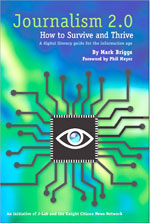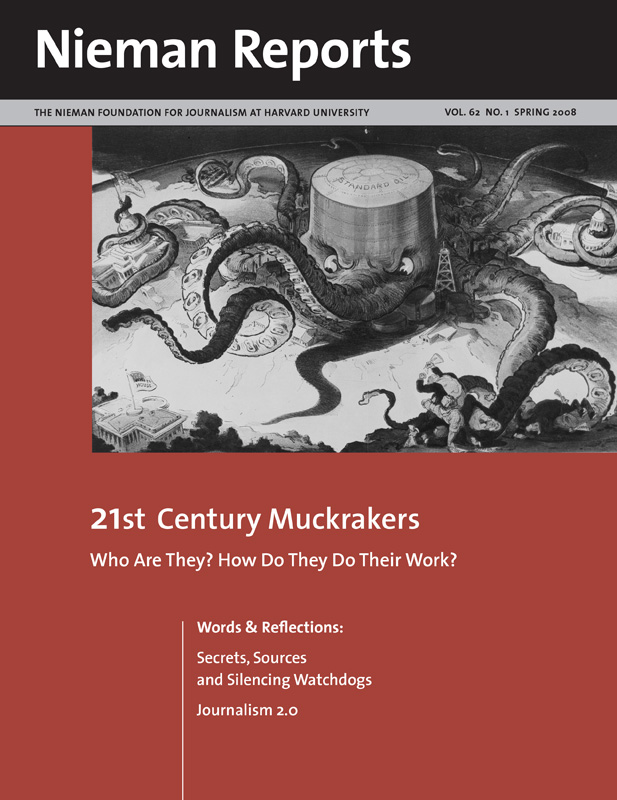 In their own time journalists have weathered a lot of tempests, but navigating the Scylla and Charybdis of the digital straits requires an entirely new level of sang-froid and fortitude. While giant media corporations scramble to protect their profits in the face of declining advertising revenues, their employees and contractors engage in a high-stakes game of musical chairs. Correspondents moonlight as bloggers on the Web sites of their own programs and publications. Writers pack video cameras when they go out to report a story. Photographers tote digital recorders, and reporters who have mastered nut grafs and a few lines of computer code are the new must-hires at many Web ventures.
In their own time journalists have weathered a lot of tempests, but navigating the Scylla and Charybdis of the digital straits requires an entirely new level of sang-froid and fortitude. While giant media corporations scramble to protect their profits in the face of declining advertising revenues, their employees and contractors engage in a high-stakes game of musical chairs. Correspondents moonlight as bloggers on the Web sites of their own programs and publications. Writers pack video cameras when they go out to report a story. Photographers tote digital recorders, and reporters who have mastered nut grafs and a few lines of computer code are the new must-hires at many Web ventures.EDITOR'S NOTE
Journalism 2.0 was commissioned by J-Lab: The Institute for Interactive Journalism as a learning module for the Knight Citizen News Network (www.kcnn.org). It was written by Mark Briggs and edited by J-Lab’s Jan Schaffer. Download a free pdf. Purchase a hard copy of the book for $12.To negotiate the ever-changing landscape, journalists should check out “Journalism 2.0: How to Survive and Thrive,” by Mark Briggs, assistant managing editor for interactive news at The News Tribune in Tacoma, Washington. Billed as a “digital literacy guide for the information age” and available as an online pdf in Spanish, Portuguese and English, “Journalism 2.0” is a handy compendium of concepts, emerging software standards, and equipment advice for the 21st century journalist, whether a dedicated amateur or a pro. Briggs’s writing has a very friendly tone, reassuring “traditionalists” that if they know how to write an e-mail or send an attachment, they, too, can prosper in an increasingly interactive news world. But in case the carrot doesn’t work, the not so subtle subtext is clear: “adapt or die.”
RELATED WEB LINK
Download "How to Write for the Web," a Spanish-language book by Guillermo Franco »My guess is that “Journalism 2.0” works best as a survey course on multimedia for folks who still don’t have a lot of experience in the field. Practicing journalists are going to get the most out of this guide by picking one or two areas on which to focus and then delving deeper than an introductory text, such as this one, will take them. Without this kind of pick-and-choose approach, journalists are likely to feel panicked by all there is to absorb—editing audio, shooting video, and designing Web sites, to mention a few. Instead, the wise approach is to build on acquired skills and experiences and look for ways to increase their value.
RELATED ARTICLE
“Journalists as Storytellers”
– Guillermo FrancoFor a print journalist, this might mean devoting six months to getting really good at recording and editing audio. What are the ambient sounds that allow your listeners to place the locale or mood of a story right away? What audio levels give the best results for a podcast or voice-over? By still relying on all of the same foundational skills of a print reporter—finding the right person to interview, ferreting out the unexpected detail—the one new element is to add sound to give the story being told a new dimension.
RELATED WEB LINK
Soundslides
– soundslides.comFor a photographer, a goal might be to master the interactive slide show by learning how to mesh audio and stills with a low-cost program such as Soundslides. Which stories are best told in a single iconic shot and which demand expansion through a timeline? When does a series of still images deliver a greater impact than a video? While still dealing with light and mood and f-stops, voice and timbre are strengthened.
After a few months devoted to feeling more secure about the basics of podcasting or interactive slide shows, it is time to see what new media technology or other applications can be used to showcase your various journalistic skills. Every few months, as new programs and devices surface, be ruthless, this guidebook advises, about which ones will serve your purposes best. Another piece of good advice: Write up your top five “lessons learned” for your own blog or your employer’s Web site and watch comments—many of them helpful—pour in.
A trend I’m paying more attention to is convergence among computer programmers and journalists. Database reporting and Computer Assisted Reporting have been used for decades to cover election results, economic statistics, and social trends. (CBS News used UNIVAC I to call the 1952 presidential election for Dwight Eisenhower hours before the national results were in.) What is changing now is the ease with which databases can be generated and even compared to one another in so-called “mash-ups.” One of the best known examples comes from Adrian Holovoty, who figured out how to display crime statistics from the Chicago Police Department on Google Maps and now lots of news Web sites are using this technique to display such statistics.
RELATED ARTICLE
“Global Efforts at Investigative Reporting”
– Fernando RodriguesGoing forward, journalists will have to evaluate ever more databases, figuring out the right questions to ask and finding effective ways to gain access to available databases throughout the world. Or journalists can lead the way by developing and sharing their databases, as a team from Folha de São Paulo recently did in Brazil. Led by Fernando Rodrigues, Folha journalists collected government-mandated financial statements of every political candidate throughout the country. The newspaper transformed these raw numbers into a giant database that they used to compare statements across several years. By doing this, the Folha team discovered that being elected to office often increased a politician’s declared wealth by 90 percent or more. Work on this project cost the paper several hundred thousand dollars. With this kind of information in hand, Folha reported on the top national political races and then, in a brilliant marketing move (by which democracy also prospered), the newspaper opened the database for public consumption. Voters could check on their representatives, and regional newspapers filed stories on local candidates using the information Folha aggregated.
RELATED WEB LINK
For more information, in Portuguese, visit www.politicos
dobrasil.com.br »For those journalists who don’t excel at generating databases—or who don’t work for a news organization like Folha with the willingness to devote resources to such a project—partnering with a friendly programmer might be the best way to explore what’s possible. If the Web 2.0 environment for news has taught us anything, it is that we are better off not going it alone.
Christine Gorman, a 2008 Global Health Nieman Fellow, was a longtime senior health writer for Time magazine. She now blogs about global health issues and journalism at www.globalhealthreport.com and maintains her own Web page at www.cgormanhealth.com.



